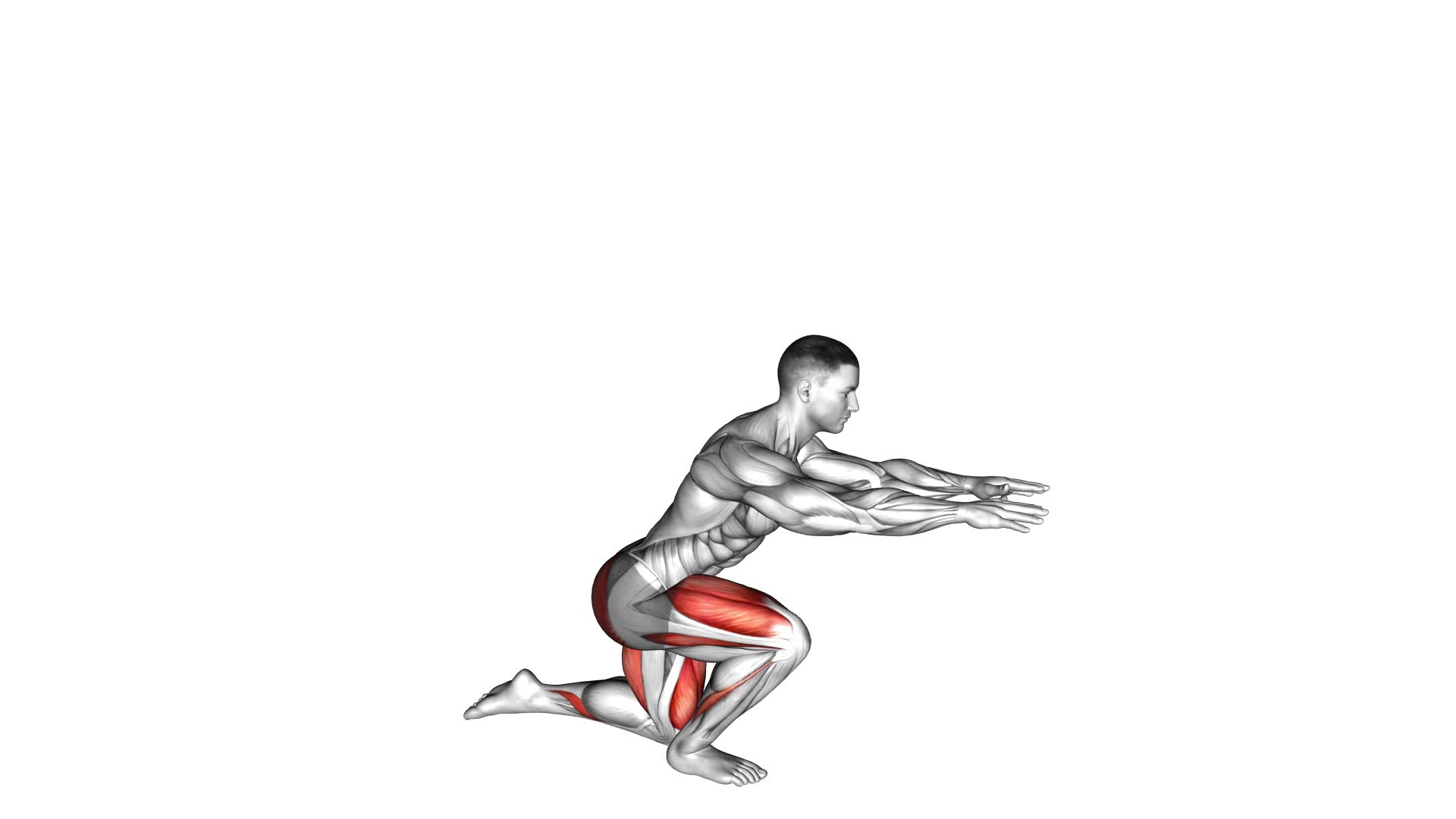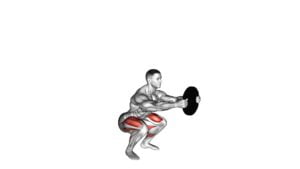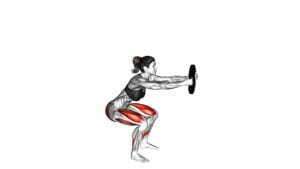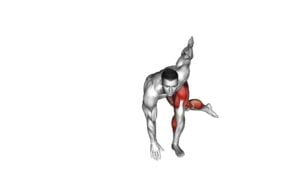Counterbalanced Skater Squat (male) – Video Exercise Guide & Tips

Get ready to tone your legs and improve your balance with the counterbalanced skater squat.
Watch This Exercise Video
In this video exercise guide, we'll show you the proper form and technique for this challenging move.
Discover the benefits of incorporating the counterbalanced skater squat into your workout routine and learn how to choose the right counterbalance weight.
Avoid common mistakes and find out how to increase the difficulty of this exercise.
Get ready to take your fitness to the next level!
Key Takeaways
- The Counterbalanced Skater Squat strengthens quadriceps and glutes.
- It improves overall lower body strength and stability.
- The exercise offers variations and modifications for different fitness levels.
- Gradually increasing the weight and difficulty of the exercise helps challenge and progress the muscles.
Benefits of the Counterbalanced Skater Squat
To get the most out of the Counterbalanced Skater Squat, you can benefit from strengthening both your quadriceps and glutes. This exercise is highly effective in activating these muscle groups, leading to increased muscle activation and overall strength in your lower body.
The Counterbalanced Skater Squat targets your quadriceps, which are the large muscles located at the front of your thighs. By performing this exercise, you engage your quadriceps and challenge them to work harder. This increased muscle activation leads to improved strength and stability in your legs, making it easier to perform daily activities and sports.
Additionally, the Counterbalanced Skater Squat also targets your glutes, which are the muscles in your buttocks. By properly executing this exercise, you engage your glutes and promote their activation. This not only helps in strengthening your glutes but also improves your overall lower body strength and power.
Furthermore, the Counterbalanced Skater Squat offers various variations and modifications to suit different fitness levels and goals. You can adjust the difficulty of the exercise by using different amounts of weight or by performing it on an unstable surface. These variations allow you to continually challenge your muscles and progress in your fitness journey.
Proper Form and Technique for the Counterbalanced Skater Squat
When performing the Counterbalanced Skater Squat, it's important to focus on maintaining balance and stability throughout the exercise. Proper form and technique are key to maximize the benefits of this movement.
To ensure you're performing the Counterbalanced Skater Squat correctly, it's crucial to avoid common mistakes that can hinder your progress.
Balance and Stability
Maintain your balance and stability throughout the counterbalanced skater squat by engaging your core and keeping your weight evenly distributed between your front and back legs. Improving balance and core strength are crucial for performing this exercise effectively.
To begin, stand tall with your feet hip-width apart, and hold a dumbbell or kettlebell in your right hand. Extend your right leg behind you, keeping it slightly off the ground, and shift your weight onto your left leg. Engage your core to stabilize your body.
As you lower your body into a squat, focus on keeping your chest up and your back straight. Keep your right leg extended behind you, maintaining a slight bend in your left knee. Lower until your left thigh is parallel to the ground or as low as you can comfortably go.
Push through your left heel to return to the starting position, maintaining control and balance throughout the movement. Repeat on the other side.
Common Mistakes to Avoid
Avoid these common mistakes when performing the counterbalanced skater squat to ensure proper form and technique, improving your technique and avoiding injury.
First and foremost, make sure you have the correct starting position. Your feet should be hip-width apart, and your weight should be evenly distributed between both legs.
Avoid leaning too far forward or backward during the movement, as this can put unnecessary strain on your knees and lower back.
Additionally, be mindful of your knee alignment. Your knee should track in line with your toes throughout the exercise to prevent any undue stress on the joint.
Finally, maintain control and stability throughout the movement. Avoid rushing through the exercise and focus on maintaining a slow and controlled descent and ascent.
Choosing the Right Counterbalance Weight
When it comes to choosing the right counterbalance weight for the skater squat, there are a few important points to consider.
First, it's crucial to select a weight that challenges you but still allows you to maintain proper form throughout the exercise.
Balancing the weight is also essential, making sure it's evenly distributed on both sides of your body.
Lastly, it's important to gradually increase the weight over time as you become stronger and more comfortable with the exercise.
Proper Weight Selection
You should regularly assess and determine the appropriate counterbalance weight for the Counterbalanced Skater Squat exercise. Proper weight selection is crucial to ensure that you're challenging yourself enough without compromising your form or risking injury. Here are some weight selection tips to help you make the right choice:
- Start with a lighter weight: It's better to begin with a weight that feels manageable and gradually increase it as you build strength and confidence.
- Use a weight that allows for proper technique: Make sure you can maintain proper form throughout the exercise. If you find yourself struggling or sacrificing your form, decrease the weight.
- Experiment with different weights: Everyone's strength and fitness level are different. Don't be afraid to try different weights to find the one that challenges you without causing excessive strain.
Balancing Form and Weight
To balance form and weight in the Counterbalanced Skater Squat exercise, it's important to choose the right counterbalance weight that challenges you without compromising your technique.
The counterbalance weight plays a crucial role in maintaining proper weight distribution and core engagement throughout the exercise. When selecting the weight, consider your strength and skill level. It should be heavy enough to provide resistance and make the exercise challenging, but not so heavy that it causes you to lose balance or compromise your form.
Experiment with different weights until you find the one that allows you to maintain proper technique while still feeling the burn in your muscles. By finding the right counterbalance weight, you can ensure that you're getting the most out of the exercise while minimizing the risk of injury.
Now, let's move on to the next section about gradual weight progression.
Gradual Weight Progression
Achieving optimal results in the Counterbalanced Skater Squat exercise requires a gradual progression of counterbalance weight. As you become more comfortable and proficient with the exercise, it's important to increase the difficulty by adding more weight.
Here are three key points to consider when choosing the right counterbalance weight for your skater squats:
- Start with a light weight: Begin with a weight that allows you to maintain proper form and perform the exercise with control. This will help you build a strong foundation and prevent injury.
- Gradually increase the weight: Once you feel comfortable with the initial weight, gradually increase the load. Aim to add small increments of weight over time to challenge your muscles and continue progressing.
- Listen to your body: Pay attention to how your body responds to the increased weight. If you experience pain or discomfort, reduce the load or take a break. It's important to find the right balance between pushing yourself and avoiding injury.
Common Mistakes to Avoid During the Counterbalanced Skater Squat
Avoiding common mistakes is crucial when performing the counterbalanced skater squat. By being aware of these mistakes, you can ensure that you're getting the most out of this exercise and avoiding any potential injuries.
One common mistake isn't focusing on improving hip mobility. The skater squat requires a great deal of hip mobility in order to perform the movement correctly. If your hips are tight, you may find it difficult to maintain proper form and balance during the exercise. To improve hip mobility, incorporate exercises such as hip flexor stretches and glute bridges into your workout routine.
Another mistake to avoid is attempting advanced variations of the skater squat before mastering the basic form. It's important for beginners to start with variations that are appropriate for their fitness level. Gradually progress to more challenging variations as your strength and balance improve.
Tips to Increase the Difficulty of the Counterbalanced Skater Squat
As you progress in your counterbalanced skater squat routine, you can further challenge yourself by introducing additional elements to increase the difficulty of the exercise. Here are three tips to help you increase the intensity of your counterbalanced skater squats:
- Increase the weight: One way to make the counterbalanced skater squat more challenging is by using a heavier weight for the counterbalance. You can gradually increase the weight as you become stronger and more comfortable with the exercise. This will add resistance and force your muscles to work harder.
- Shorten the rest periods: Another way to increase the difficulty of the counterbalanced skater squat is by reducing the amount of rest time between sets. By decreasing the rest periods, you're challenging your muscles to work harder and endure more fatigue. This can help improve your endurance and overall strength.
- Try alternative exercises: To further increase the intensity of your skater squat routine, you can incorporate alternative exercises that target the same muscle groups. Some examples include weighted lunges, pistol squats, or Bulgarian split squats. These exercises engage similar muscles as the skater squat and can help add variety and challenge to your workout routine.
By implementing these tips, you can continue to progress and push yourself to new limits in your counterbalanced skater squat routine.
Now, let's move on to the next section to explore a sample workout routine that incorporates the counterbalanced skater squat.
Sample Workout Routine Incorporating the Counterbalanced Skater Squat
To implement the counterbalanced skater squat into a sample workout routine, start by incorporating it as the first exercise to target your lower body muscles. This exercise is an excellent way to build strength and stability in your legs and glutes.
Begin by standing with your feet shoulder-width apart, holding a dumbbell or kettlebell in front of your chest to counterbalance your body. Take a step back with one foot, crossing it behind the other leg. Lower your body down into a squat position, keeping your chest up and your weight in your front heel. Push through your front heel to raise your body back up to the starting position. Repeat the exercise for 8-12 repetitions on each leg.
After completing the counterbalanced skater squats, you can continue with your sample workout routine. Consider adding exercises that target other muscle groups, such as lunges, deadlifts, or calf raises to create a well-rounded lower body workout.
To increase the difficulty of the routine, you can add more weight to the counterbalance or use a higher step for the skater squat. You can also increase the number of repetitions or sets for each exercise.
Remember to always maintain proper form and listen to your body's cues to prevent injury. As you progress, you can gradually increase the intensity and challenge of your routine to continue challenging your muscles and seeing progress.
Frequently Asked Questions
How Many Sets and Reps Should I Do for the Counterbalanced Skater Squat?
For the counterbalanced skater squat, it's important to consider the number of sets and reps you do. The ideal amount may vary depending on your fitness level and goals.
To start, try doing 3 sets of 8-10 reps on each leg. This will help build strength and stability in your lower body.
As you progress, you can increase the number of sets or reps to continue challenging yourself. Remember to listen to your body and adjust accordingly.
Can I Use Dumbbells as a Counterbalance Instead of a Kettlebell?
Yes, you can definitely use dumbbells as a counterbalance instead of a kettlebell in the skater squat. It's a great alternative if you don't have access to a kettlebell.
Using dumbbells as a counterbalance in this exercise can provide similar benefits to using a kettlebell, such as improving lower body strength and stability.
Just make sure to choose dumbbells that are challenging but manageable for you, and maintain proper form throughout the exercise.
Should I Perform the Counterbalanced Skater Squat Before or After My Main Leg Exercises?
To maximize the effectiveness of your leg workout routine, it's important to know when to perform the counterbalanced skater squat. Before or after your main leg exercises?
Well, incorporating this exercise before your main leg exercises can help activate your muscles and improve stability. On the other hand, performing it after can help fatigue your muscles even more. Ultimately, it depends on your goals and preferences.
Now, let's dive into the benefits and proper execution of the counterbalanced skater squat for maximum results.
Can Beginners Perform the Counterbalanced Skater Squat?
Beginners can definitely perform the counterbalanced skater squat, but it's important to start with modifications. Instead of using weights, you can begin by using a chair or wall for support. This will help with balance and stability.
Another common mistake to avoid isn't maintaining proper form. Keep your chest up, core engaged, and knees aligned with your toes.
With practice and proper technique, beginners can gradually progress to the full exercise.
Is It Normal to Feel a Burning Sensation in My Quads During the Counterbalanced Skater Squat?
Feeling a burning sensation in your quads during the counterbalanced skater squat is normal. This exercise specifically targets your quadriceps, so you can expect a high level of muscle activation in that area.
The burning sensation indicates that your quads are working hard to stabilize and control your movements. It's a sign that you're challenging your muscles and building strength.
Just make sure to listen to your body and stop if you experience any sharp or intense pain.
Conclusion
In conclusion, the counterbalanced skater squat is a highly effective exercise for strengthening the lower body, particularly the glutes, quads, and hamstrings. By using a counterbalance weight, this exercise challenges your stability and improves your balance.
It's important to maintain proper form and technique to avoid injury and maximize results. Incorporating the counterbalanced skater squat into your workout routine can help you achieve stronger and more toned legs.
So grab a weight and start squatting!

Author
Years ago, the spark of my life’s passion ignited in my mind the moment I stepped into the local gym for the first time. The inaugural bead of perspiration, the initial endeavor, the very first surge of endorphins, and a sense of pride that washed over me post-workout marked the beginning of my deep-seated interest in strength sports, fitness, and sports nutrition. This very curiosity blossomed rapidly into a profound fascination, propelling me to earn a Master’s degree in Physical Education from the Academy of Physical Education in Krakow, followed by a Sports Manager diploma from the Jagiellonian University. My journey of growth led me to gain more specialized qualifications, such as being a certified personal trainer with a focus on sports dietetics, a lifeguard, and an instructor for wellness and corrective gymnastics. Theoretical knowledge paired seamlessly with practical experience, reinforcing my belief that the transformation of individuals under my guidance was also a reflection of my personal growth. This belief holds true even today. Each day, I strive to push the boundaries and explore new realms. These realms gently elevate me to greater heights. The unique combination of passion for my field and the continuous quest for growth fuels my drive to break new ground.



